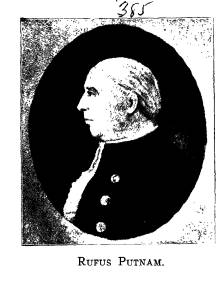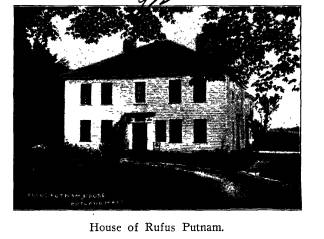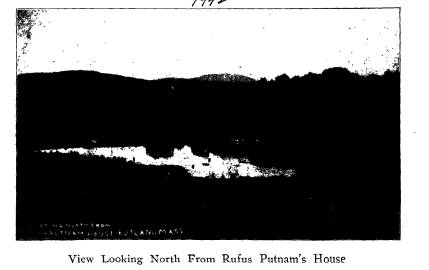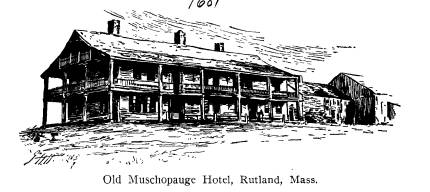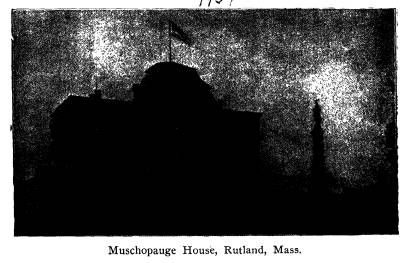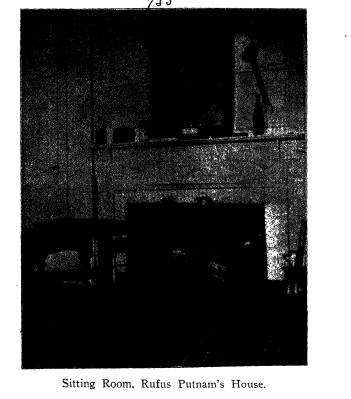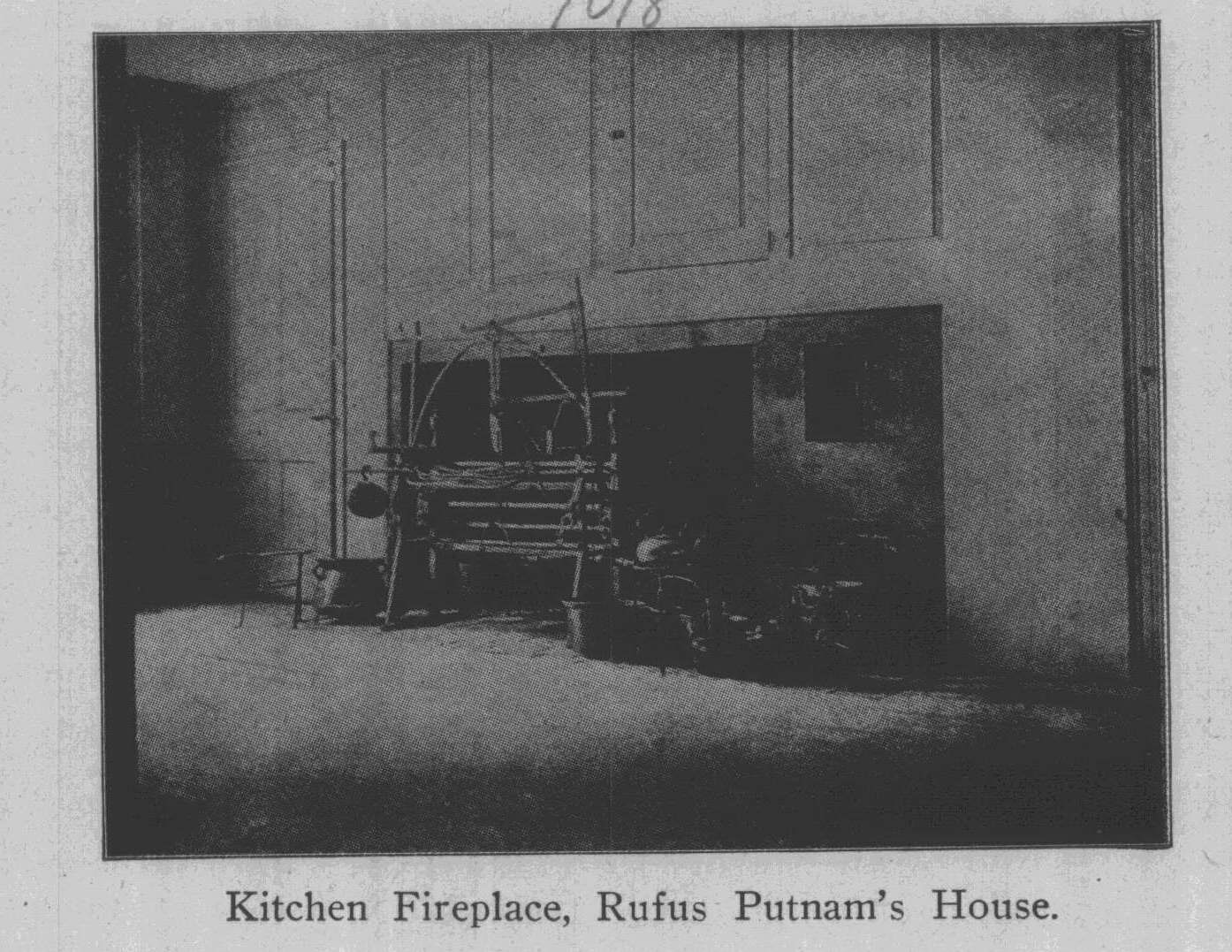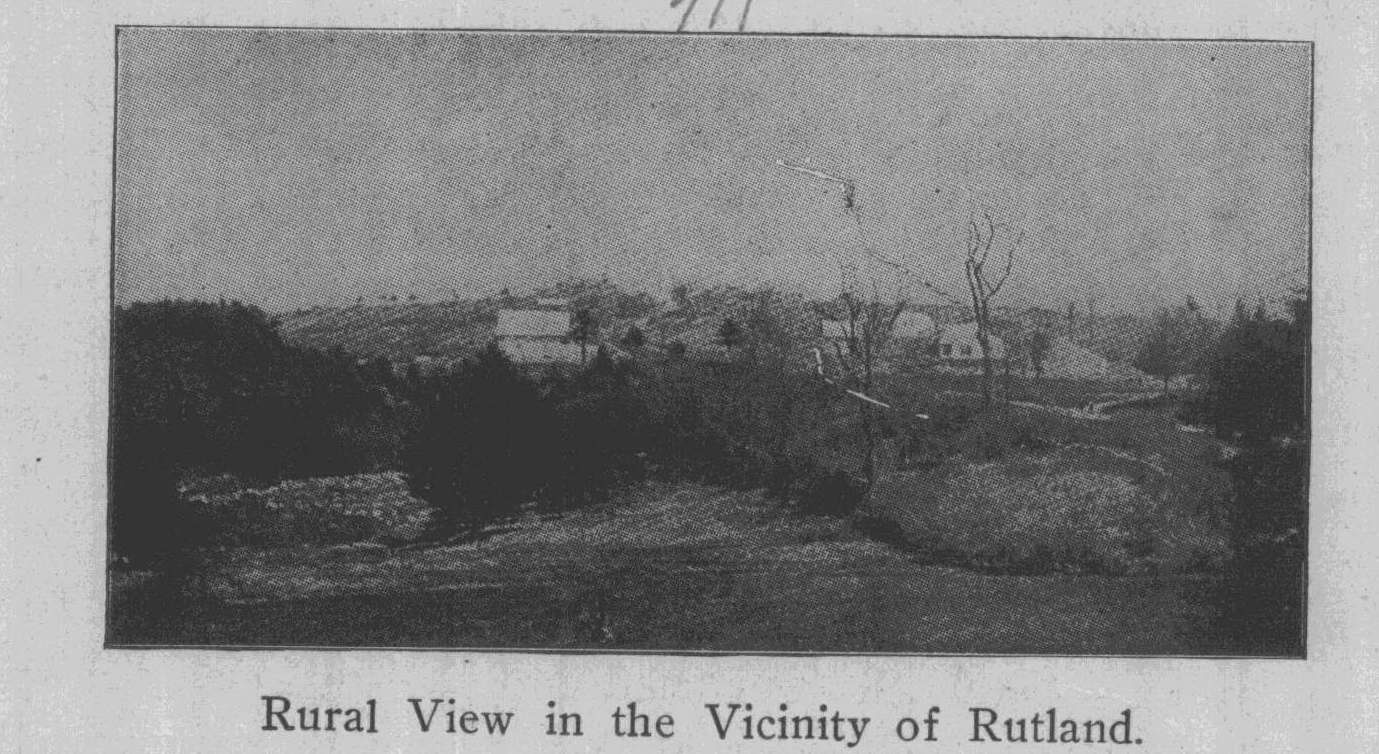Ohio History Journal
|
RUTLAND-"THE CRADLE OF OHIO."
A LITTLE JOURNEY TO THE HOME OF RUFUS PUTNAM. E. O. RANDALL. It was in the bright and cheery days of September, 1908, that the Editor left the palatial Pullman car at Worcester and |
|
boarded a trolley that bore him along a rambling route amid tiny lakes and quiet hills to the little burg of Jef- ferson. Here the trolley was exchanged for a motor bus, the electric wings of which fluttered with intermittent and uncertain rapidity till the pas- sengers were delivered at the steps of the broad piazza of the Muschopauge hotel, a hos- pitable and spacious summer abode crowning the hill which boasts of being one of the highest elevations of the noble commonwealth of Massachu- setts. Certainly the "Cradle. |
|
of Ohio" was most picturesquely chosen. Rutland lies in the center of the state and from the lookout of the afore- said hostelry an unsurpassed panorama meets the eye, a scene where mountains rise, umbrageous dales descend, sparkling lakelets dot the plains and rippling rivulets run their sil- ver courses around the feet of tree-clad hillsides. Rutland is on the midway divide between the valleys of the Connecticut and Merrimac rivers. It revels in the pride of its position and we were told that on a clear day the spectator's range of vision sweeps in the blue hills of Milton, near the Atlantic, the High- lands on the Connecticut, while Wachusett rises close at hand in the adjacent town of Princeton, and old Monadnock, mon- arch of all he surveys, rears his rugged outline against the north- 54 |
Rutland- "The Cradle of Ohio." 55
ern sky. From this same outlook, which
boasts an elevation of
1,250 feet above the sea level, the
pointed spires of fourteen
surrounding towns may be seen. The good
people of Rutland
are not cramped for residence space.
Perhaps a thousand in-
habitants abide within its precincts.
Its external appearance and
characteristics have hardly changed in a
couple of centuries. Its
principal street, a mile and a half long
and some two hundred
feet wide, runs through the village
center. From this spacious
avenue the side streets cut at right
angles. The large, home-
like, frame houses, natty and trim as
freshly dusted band-boxes,
stand today as many stood before the
days of the American
Revolution. Time cuts no figure in a New
England village.
There is not a street lamp or light in
Rutland, and when the
shades of night envelope its clean and
garden like thoroughfares,
and the stars and moon are veiled, those
who do not intuitively,
or by habit, know their way, must like
the watchman in "Much
Ado About Nothing" carry a lantern.
But little wonder the
good Rutlanders strive to keep their
quiet and peaceful village
in all its pristine purity and beauty.
It may have the evidences
of antiquity, but its old age is not
that of decaying decline, but
rather that which the poet has depicted
as "serene and bright."
But if Rutland has the charm of restful
quiet and pictorial sim-
plicity it has the greater enchantment
of historic perspective.
History reveals that the site of this
time honored town was
purchased from the Indian possessors by
the early colonists in
December, 1686. The record of this real
estate transaction is
still extant; the names of the grantees
to the deed being "the
marks of five Indians with long,
unpronounceable names, setting
forth that, for the sum of twenty-three
pounds, they sell to six
white men, properly named, a tract of
land twelve miles square,
the boundaries thereof being
specified." This tract included
several towns besides Rutland and was
the very heart of the
state. Later a six-mile square tract was
surveyed off the above
purchase and named "Rutland,"
presumably from the town or
the Duke of Rutland in England. But if
the Indians sold the
land for a good price and gave
possession and title, it did not
prevent the simple and guileless
children of the forest from pro-
ceeding to massacre and tomahawk the
first settlers. Such was
the fate, with others, of Rev. Joseph
Willard, the first minister,
56 Ohio Arch. and Hist.
Society Publications.
who was accorded the "ministry
lot"-one of the sixty-three
into which the town was divided-and upon
which the par-
sonage in the shape of a log fort was
built. The militant min-
isterial mansion was incorporated into
the original village inn,
which was later superseded by the
present ample and inviting
Muschopauge House, now the popular
caravansary for summer
seekers after invigorating air,
entrancing scenery and historic
reminiscence. Old England, itself,
presents no more park-like
drives than do those leading for miles
in every direction from
Rutland, as we may testify from
experience through the cour-
tesy of Mr. Louis N. Hanff, long time
resident and town clerk
of Rutland. But the allurements of
Rutland's scenic attrac-
tions must not entice us from the
historic purpose of our visit.
On the eastern outskirts of the village,
almost the last house
on the north side of the broad main
avenue, back some two
hundred feet from the road and fronted
by many stately repre-
sentatives of the olden forest, that
like perpetual sentinels guard
the approach, is the Rufus Putnam House.
It stands intact,
unsullied, almost precisely as it stood
a century and a half ago.
It is one of the most substantial and
imposing residences in the
town and is a well preserved specimen of
the architecture of its
day. It was built about the middle of
the eighteenth century,
by one then known as Colonel John
Murray. Many years be-
fore when a boy he left his native
Ireland as John McMorroh
and immigrated to the American Colonies.
He landed without
means save his energy and thrift. He
settled in Rutland and
became its wealthiest and most prominent
citizen, acquiring
much land and living like a luxurious
Tory, for such he was,
having no sympathy with the colonial
sentiment of independence.
He was married twice in Rutland and the
large tombstone of
his wives may still be seen in the
village cemetery. He built
several houses in Rutland for his
children, when they married
and left the paternal roof. The house in
question was the home
of his second daughter who married
Daniel Bliss of Concord.
But the tide of the Revolution brought a
turn in the affairs of
Colonel Murray. He was the town's
representative to the
General Court of the Colony at the time
of the Stamp Act. The
people of Rutland were against the
odious law - their repre-
sentative misrepresented them. In a
communication couched in
|
Rutland - "The Cradle of Ohio." 57
no dubious terms, the patriots admonished the colonel to adhere to the wishes of the loyal colonists and not to those of oppres- sive England. He heeded not the admonition but accepted the appointment of collector of revenues by Great Britain. A sam- ple incident of the times occurred. Colonel Murray was given to understand that it would be conducive to his health to seek residence elsewhere. He hastily departed "in the night by un- frequented roads of the country and escaped to Nova Scotia." His several homes were confiscated and sold. The fine Rutland home was purchased by Rufus Putnam in 1780, while the latter was engaged in the War for Independence. |
|
|
|
Who and what was Rufus Putnam? He descended from the sturdiest Anglo Saxon stock that came from Old England in the early colonial days. He was born at Sutton, Mass., April 9, 1738, in the fifth generation from John Putnam who with his family emigrated to America from their English Bucking- hamshire home in 1634. When the boy was but seven years of age his father died. A year or two after his widowed mother married Captain John Sadler. The illiterate and unsympathiz- ing stepfather denied the boy the most meagre means of educa- tion but it was the familiar story of unavailing attempts to smother the irresistible yearnings in the mind of an ambitious |
|
58 Ohio Arch. and Hist. Society Publications.
boy. Sadler entertained travelers who often gave the boy "tips" for services rendered. With the money thus obtained powder and shot were purchased, an old shot gun was pressed into service and the birds "brought down" sold. From this game fund a spelling book and arithmetic were secured. His patience and persistency did the rest for he was his own and only teacher. A boy that would push through such a prepara- tory school was booked to graduate in the university of success. In the Spring of 1754, when scarcely sixteen he was bound as an apprentice to the mill-wright trade, one of the most im- |
|
portant businesses of the times, under Daniel Mathews, of Brookfield. This service lasted three years during which Rufus gained steadily in rudimentary book "larnin," in practical knowl- edge and experience and in physical growth and prowess, for he became an athlete in size and strength, measuring full six feet in stature with brawny limbs and toughened muscles. His apprenticeship was at an end. He had impatiently awaited its close. The French and Indian War began with it. The strug- gle between France and England over their rival claims for American territory was at its height. The colonies were con- |
|
|
Rutland- "The Cradle of Ohio." 59
ending for the supremacy of their mother
country. Thus far
the gage of battle lay mostly with the
French. Widespread
alarm stirred the colonists throughout
New England, as well as
in Pennsylvania and Virginia. We may
well imagine how the
sentiments of ambition, adventure and
colonial patriotism stirred
the spirit of the restless youth. Freed
from the apprenticeship
of the mill and farm he eagerly sprang
into military service. It
was in March, 1757, that the raw recruit
set out with his com-
pany. That his self instruction was
unusually successful is
proven by the diary which he fully and
faithfully kept during
his enlistment which lasted in all some
three years. The origi-
nal manuscript, yellow with age, of this
priceless journal in Put-
nam's handwriting, is now preserved in
the Library of Marietta
College. It is not pertinent to our
narrative that we follow the
career of the soldier in this
interesting campaign of the Seven
Years War. He was with the section of
the English and
colonial troops who maneuvered about the
localities of the
upper Hudson and Lakes George and
Champlain. His first taste
of the soldier's hunger, cold, suffering
and danger was with the
Ranger scouts about Fort Edward. Here he
came in contact
with the Indian mode of warfare,
witnessed for the first time
the inhuman barbarities with which the
savage allies of the
French tortured and butchered their
prisoners. Here too, he
came in touch with the distinguished
cousin of his father, Cap-
tain Israel Putnam, who had already
displayed the qualities of
an able and dauntless warrior, traits
that made him so famous
in the subsequent revolt of the
colonies. Rufus at once ad-
mired his dashing relative and learned
from him many lessons
of military tactics. Our volunteer was
witness to the siege and
capture of Fort William Henry by the
Marquis de Montcalm
and his overwhelming army of French and
Indians. After
severe sufferings in the camp and on the
march in the bitter win-
ter Putnam was honorably discharged and
reached home in Feb-
ruary (1758). But the war was far from
ended. Until now
it had been a continued series of
disaster and disgrace for the
Crown and her colonies; one British army
after another had
been defeated or captured. The banner of
the Bourbons was
being borne into the very heart of the
British possessions. The
|
60 Ohio Arch. and Hist. Society Publications.
people of England alarmed and disheartened clamored for a new hand at the governmental helm. George II yielding to the popular pressure, called William Pitt, the "great commoner," to guide the floundering course of England. Pitt's tremendous force and sagacity instantly aroused the English arms every- where. French armies were repulsed in India, in Africa, in Europe, and in America. The colonists were enthusiastic in their admiration for Pitt and their confidence was unbounded. Twenty-five thousand colonial troops were raised and added to the twenty-five thousand Royal Regulars from England, and General Abercrombie, the new English commander, thus lead a force of fifty thousand against the twenty thousand French armament. Rufus Putnam re-enlisted. The campaign was that |
|
|
|
of 1758 about Lake George. It did not add to the glory of Abercrombie or the advantage of England. The end of the year found Putnam again at the Sutton home. In the Spring (1759) he enlisted for the third time. His company was under General Amherst in the attack on Fort Ticonderoga. The French forces yielded the Fort, embarked on Lake Champlain for Crown Point, a strong fort which the French blew up and then continuing their retreat proceeded on down the lake to Montreal. The reason of the precipitate withdrawal of the French from their intrenched positions was the news of Gen- eral Wolfe's advance on Quebec. In March, 1760, Rufus Put- nam again answered the call for troops for another campaign. |
Rutland- "The Cradle of
Ohio." 61
His company was stationed at the outlet
of Lake George and
there remained till the end of the war.
In the Spring of 1761,
when he returned to his home, this time
New Braintree, and
his employment of building mills and
farming he had become
inured to the hardships of a soldier's
life and skilled in the arts
of warfare both savage and civilized.
This education was his
preparation for the later achievements
of his career.
In April, 1761, our hero took for a wife
Miss Elizabeth
Ayres, whose father was a wealthy
landholder of Brookfield.
Sorrow quickly followed his new
happiness for within a year
the death of his wife and a little son
left him wifeless and child-
less. Four years later he was married to
Miss Persis Rice of
Westborough, Mass. It was a fortunate
and congenial alliance
lasting more than half a century and
from which union many
children were born. After his service in
the French and Indian
War, Putnam for a few years pursued the
vocation of building
mills and of farming. He then turned his
attention to survey-
ing, in those days a lucrative,
honorable and much sought
business. This practical acquisition was
another valuable step
in his preparation for later
accomplishments. Immediately fol-
lowing the Seven Year's War the British
Government established
three new provinces out of their newly
acquired American terri-
tory, viz.: (I) Quebec, which included
not only French Canada
but the domain between the Ohio, the
Great Lakes and the Mis-
sissippi, later known as the Northwest
Territory: (2) East
Florida, and (3) "West Florida. The
British Government also
granted their regular troops certain
portions of American land
for their military services.
Subsequently the crown and council
reluctantly included the Colonial troops
in this land reward.
Land for this purpose was to be set
apart in West Florida and
in the winter of 1772-3 Rufus
Putnam with a number of others,
one of whom was Colonel Israel Putnam,
left their New Eng-
land homes to locate and secure Florida
reservations. The party
was known as "The Military Company
of Adventurers." They
sailed from New York in the sloop
"Mississippi," coasted along
the shores of Florida, visited Jamaica
and Cuba, and thence
proceeded to the mouth of the
Mississippi River, which they
navigated up as far as the mouth of the
Yazoo, whence they
|
62 Ohio Arch. and Hist. Society Publications.
returned down the river and to New York by the route pursued from the start. This journey occupying many months was one of great interest and profit to Putnam, giving him accurate knowledge of the vast territory traveled, its rivers and re- sources; its extent and opportunities. He came in contact with the Spanish and French settlements and the chief settlements of the various southern Indian tribes. No lands were secured, owing to conflicting conditions existing between the Crown gov- ernment and the colonial authorities. The King's promises to the colonial soldiers proved unavailing. Putnam however, sur- |
|
veyed certain sections of East Florida and so favorably reported the advantages of the country that many New England families' emigrated thither and settled. Thus ended the expedition of the "Company of Military Adventurers." It was a sample dream of expectations that was dispelled in a rude awakening. It was the close of the year 1773, when members of this land-grant party returned to their Massachusetts and Connecticut homes. The rumblings of the Revolution were becoming more and more audible. The storm burst on the Commons of Lexington and the Bridge of Concord in April, 1775. Rufus Putnam, in ardent sympathy with the cause of the colonies, entered the army as |
|
|
Rutland--"The Cradle of Ohio." 63
lieutenant colonel of Colonel David
Brewer's regiment, stationed
at Roxbury. We cannot follow our subject
through the details
of the Revolution. It is not necessary
to our purpose. As be-
fore in his military campaigns, he kept
a complete journal of
his doings and the events through which
he passed. Like Wash-
ington, Putnam is his own best
biographer. The manuscripts
of his handwriting are the bases of
nearly all that has since been
written concerning him. His rise to
influence and fame in the
Revolutionary ranks however deserves
passing note. General
Thomas was in charge of Roxbury. It was
unprotected save
by a "board fence." A council
of officers was held to consider
means of defense. Engineers were rare
and where was there
a man to execute the work in hand? To
General Thomas it was
suggested that among his officers was
Colonel Rufus Putnam
who had engineering experience in the
late French and Indian
War. On being summoned by the General,
Colonel Putnam
frankly stated as his journal reads,
that he "had never read
a word on the subject of fortification;
it is true that I had
been employed on some work of that sort
under British engineers
but I pretended to no knowledge in
regard to laying out works.
But no excuse would avail. Undertake I
must." And under-
take he did. The defenses were erected
at Roxbury and proxi-
mate points. Generals Washington and Lee
came over to ex-
amine the defenses. Both generals spoke
words of entire ap-
probation. Rufus Putnam had found his
place in the Revolu-
tionary ranks and in the esteem and
confidence of the Colonial
Commander. The rest is easily told. The
defenses about Dor-
chester, Cobble Hill and elsewhere were
Putnam's work. At
Washington's request he made surveys and
maps of courses,
distances and relative situations of the
army's works in
Cambridge, and its vicinity. He
accompanied General Lee to
Providence and Newport planning
batteries and elevations. In
the Winter of 1776, Washington was
engaged in plans to dis-
lodge the British from Boston. General
William Howe occupied
the city with eight thousand of his
Majesty's choice troops.
These could be supplemented at a moment's
notice from the
ships that "rode gaily in the
harbor." Large reinforcements
were expected in the Spring. The
situation demanded that
64 Ohio Arch. and Hist.
Society Publications.
something be done. Washington assembled
his generals in con-
sultation. Putnam was present by special
invitation, and re-
tained by the commander after all others
had left. Washington
doubted the result of storming the city.
It would be better, if
possible, to draw the enemy out toward
Dorchester, and attack
them there. If the colonists could
maintain themselves on the
landneck between Boston and Dorchester
they would command
the city and harbor. But the intense
cold had so deeply frozen
the earth that the excavating of it and
erection of entrench-
ments therewith was impossible. There was the problem.
Washington left it to Putnam to invent a
solution. On his
return to his quarters Putnam stopped at
the quarters of General
Heath. On the general's table lay a copy
of Muller's "Field
Engineer." Putnam had never read a book on the subject.
He borrowed Muller. His eye quickly fell
on the word
"Chandelier." The problem was solved. His entrenchments
were made of Chandeliers. The adjacent
apple orchards and
woodlands supplied the lumber. Stout
timbers, ten feet long
were cut, into which were set upright
posts five feet high and
five feet apart. These framework
arrangements were placed up-
right loosely on the frozen ground in
two parallel lines a short
space apart and fastened together by
connecting timbers. The
open space between the parallels was
filled with bundles of sticks
and branches. Thus was made a movable
parapet, an entrench-
ment of wood, easily set up wherever
most serviceable. The
British soldiers in Boston, retired on
the evening of March 4th
secure in the idea that the Colonists
were helpless in their efforts
to dislodge them from the city. On the
following morning the
"King's own" arose and rubbed
their eyes in bewilderment, for
they beheld the colonial patriots
completely protected by a de-
fense that had arisen as if by magic. It
was a typical incident of
Yankee ingenuity and industry. It has
been truly said that these
unusual and unexpected defenses
frightened Howe into evacu-
ating Boston. Putnam was now
Washington's engineering re-
liance, and in August, 1776, on
recommendation of the American
Commander, Putnam was appointed by
Congress as engineer
with rank and pay of colonel. From that
time on he was one of
Washington's chief and most trusted
confidants. He rendered
Rutland - "The Cradle of Ohio." 65
conspicuous services in the siege of New
York by the British.
At the close of the year he withdrew
from the engineering de-
partment and was made colonel of a
Massachusetts regiment.
This placed him where he wished to be,
in the active and fight-
ing field and in the Burgoyne campaign
he, with his brave
Massachusetts men, again traversed the
ground that had become
so familiar to him in the French War.
But he could not escape
the responsibility of his engineering
ability. Again and again
he was consulted by Washington and the
other colonial generals.
Of all the foreign engineers who had
been engaged and em-
ployed, not one had yet been found with
the sound judgment
and practical skill of this untaught
American. His advice and
co-operation were constantly in demand
wherever the Continental
Troops were struggling for advantage. At
the close of 1779
Colonel Putnam was transferred to the
command of a regiment
of light infantry, one of the four
regiments composing the
brigade of General Anthony Wayne. This
brigade was regarded
as the "flower" of the army
and the officers were chosen by
Wayne himself. It was a great and
coveted distinction to serve
in Wayne's legion. It was in the latter
part of this Winter
(1780) that Putnam got leave of absence to visit his family
with
whom he remained several weeks and
during this furlough he
purchased the Rutland residence and
thereto removed his family
which had been living at North
Brookfield. From now on to the
close of the Revolution Putnam moved
amid the vicissitudes of
war, sustaining his reputation for
ability, sagacity, resourceful-
ness and indubitable confidence and
courage. The course of the
war was inseparably part of his career.
He evinced traits of
statesmanship no less than those of the
military strategist. Twice
he was influential and tactful in
assisting in the efforts to suppress
desertion and even revolt of the
Colonial Troops because of
their lack of proper equipment,
provision and pay. The rising
republic was bankrupt and its army more
or less in a constant
state of want and distress. As early as
the beginning of 1781
Putnam foresaw the difficulties of
providing for these veterans.
penniless and homeless as they surely
would be at the end of the
war. He addressed a long letter to the
General Court or Legis-
lature of Massachusetts describing the
current grievances of the
Vol. XVIII-5.
66
Ohio Arch. and Hist. Society Publications.
troops and counseling the adoption of
means for their sus-
tenance when the war should close. Like
many another he him-
self grew weary and despondent over the
situation and would
have withdrawn from the army but
Washington wrote him
(December, 1782) to hold on, he could
not spare so valuable
and trusty an officer. On January 8th
(1783) Congress made
Putnam
a Brigadier-General. This
deserved recognition
strengthened his patience and stimulated
his patriotism. With
renewed zeal as a soldier he remained
with the fortunes of the
army till the declaration of peace,
April 9, 1783.
In June following the peace and before
the final disband-
ment of the army at New Windsor, the
officers to the number
of 283, belonging chiefly to the
northern states, petitioned Con-
gress for a grant of land in the western
country. General
Rufus Putnam, in their behalf, addressed
a letter to General
Washington on the subject urging the
latter's influence with
Congress in the matter. This letter at
some length courteously
and forcefully presents the situation.
It is a masterful docu-
ment and one of the preliminary steps
towards the settlement of
Ohio. He notes the vast importance to
the United States of
the acquisition of the Northwest
Territory. The necessity of
securing the allegiance of the Indian
tribes thereof, suggesting
as instruments towards that peaceful
alliance the establishment
of garrisons at important western points
on the Lakes, and for
the security of probable settlements a
chain of stockade forts
from the Ohio, on the Muskingum or
Scioto northward to De-
troit. He had wonderful knowledge of and
insight into the
Indian situation and its liabilities.
"This whole tract," he
writes, "is supposed to contain
about seventeen million, four
hundred and eighteen thousand, two
hundred and forty acres."
The land to which the soldiers were
entitled by resolve of
Congress would amount to two million,
one hundred and
six thousand, eight hundred and fifty
acres, or one-eighth
of the whole. He closes by expressing
the probability that
"the country between Lake Erie and
the Ohio will be filled
with inhabitants, and the faithful subjects
of the United
States so established on the waters of
the Ohio and the
lakes, as to banish forever the idea of
our western territory
Rutland-- "The Cradle of
Ohio." 67
falling under the dominion of any
European power." In April,
1784, Putnam wrote another letter to
Washington concerning
the position of the officers aforesaid.
He says the settlement
of the Ohio country is constantly on his
mind, others look long-
ingly in the same direction: "We
are growing quite impatient,
and the general inquiry now is, when are
we going to the
Ohio?" In the summer of 1785 Putnam
was engaged by the
state of Massachusetts to survey the
latter's lands on the Bay
of Passamaquoddy. The state authorities
also appointed him
on the committee for the sale of the
state's eastern lands. At
the same time he was appointed by
Congress one of the sur-
veyors of the national lands, northwest
of the Ohio river. That
Putnam might fulfill his contract with
the state of Massachu-
setts, he got Congress to appoint
General Benjamin Tupper tem-
porarily, in his place, until he could
devote himself to the office.
As Mr. Tupper now enters the thread of
our story to be an
inseparable factor in it to the end, a
few words as to his iden-
tity will not be amiss. His life runs
singularly parallel to that
of Rufus Putnam. Benjamin Tupper was
born at Stoughton,
Mass., the same year that saw the birth
of Rufus Putnam.
While a mere lad Benjamin's father died
and the boy, like
Rufus, had to enter the school of
self-support and hard-knocks.
He was a private soldier in the French
and Indian War, and
was one of the first to enlist in the
Colonial ranks at the out-
break of the Revolution. He began as
lieutenant of a company
but for bravery and activity in service
he was rapidly promoted
until at the close of hostilities he
bore the title of a brigadier-
general. Also like Putnam, Tupper became
expert as a sur-
veyor. In his military career General
Tupper came in contact
with both Generals Rufus Putnam and
Washington. During
the Revolution, Washington constantly
turned the attention of
his officers and soldiers to the valley
of the Ohio, which he had
visited and the opportunities of which
he thoroughly compre-
hended. Tupper had therefore learned
much of the western
El Dorado. The Ordinance by Congress of
1785 provided for
a survey of a portion of the lands
northwest of the Ohio river.
In the summer of that year a battalion
of the first regiment of
United States troops, as a defense
against the Ohio Indians, had
|
68 Ohio Arch. and Hist. Society Publications.
taken post at the mouth of the Muskingum under command of Major Doughty and erected a fort which received the name of Fort Harmar. It was about this time that Putnam was named by Congress to survey a portion of the lands in Ohio. General Tupper was made his temporary substitute, but the Indian hos- tilities in the Ohio country prevented any surveying until after |
|
|
|
the treaty with the savages made by General Parsons and other United States agents, on the Miami in July, 1786. Tupper had gotten as far as Pittsburg in his proposed western surveys. He was obliged to return to his Massachusetts home when he made so favorable a report, from what he had learned, of the fertil- ity and beauty of the trans-Alleghany country that General |
Rutland--"The Cradle of
Ohio." 69
Putnam decided to join with him in
proposing an association for
the purchase of western lands and the
settlement thereon. Ac-
cordingly these two veteran generals,
strengthened and sea-
soned by the experiences of the two
wars, yet in the prime of
life and their powers, met on the 9th
of January, 1786, at that
historic Putnam home in Rutland. The two
projectors of the
enterprise sat up the entire night
discussing and maturing plans
that were to result in the founding of a
western empire. What
would we give for a snap-shot of those
two nation builders
seated before that spacious old
fireplace in their wigs and knee
breeches, smoking their pipes and no
doubt refreshing their
"inner man" with draughts that
cheered - for what other pur-
pose would have been that capacious
cellar - as they consulted
maps of the Ohio country and eagerly
considered ways and
means. It was a dream of empire to be
realized beyond the
imagination of man. The result of that
memorable conference
was that the two promoters united in a
publication which ap-
peared in the public papers of New
England on the 25th of
January, 1786, headed
"Information," and dated January 10th,
1786, and signed Rufus Putnam, Benjamin
Tupper.
The "Information" was a public
notice addressed to all
officers and soldiers who served in the
"late war" and who were
by ordinance of Congress (1785) to
receive certain tracts of
land in the Ohio country and also all
other good citizens "who
wished to become adventurers in that
delightful region" to meet
in certain towns specified in the
different counties of the com-
monwealth of Massachusetts-and
inhabitants in other states
as should be subsequently agreed upon-to
appoint delegates
to a meeting to be held at the Bunch of
Grapes Tavern in Bos-
ton, March 1, 1786, to form an
association by the name of the
Ohio Company. The counties and towns for
the respective
meetings were named in the notice. In
accordance with the
various meetings held, there met at the
Bunch of Grapes Tav-
ern on March 1, delegates chosen from
eight counties. They
were:
Winthrop Sargent and John Mills, from
Suffolk;
Manasseh Cutler, from Essex; John Brooks
and Thomas Cush-
ing from Middlesex; Benjamin Tupper,
from Hampshire;
Crocker Sampson, from Plymouth; Rufus
Putnam, from Wor-
|
70 Ohio Arch. and Hist. Society Publications.
cester; John Patterson and Jahlaliel Woodbridge, from Berk- shire, and Abraham Williams, from Barnstable. This meeting elected General Rufus Putnam chairman of the convention and Major Winthrop Sargent, clerk. Putnam, Tupper and others glowingly described the Ohio country and its advantages as a place of settlement. A committee consisting of Putnam, Cutler, Brooks, Sargent and Cushing was named to draw up articles of association. The "convention" met again March 3d, to hear the report of the committee. These articles of agreement for "con- stituting an association of the Ohio Company" were lengthy |
|
|
|
and elaborate. The articles state the design of the association to be to raise a fund in continental specie certificates "for the sole purpose and entire use" of purchasing lands in the western territory. The fund was not to exceed one million dollars in continental specie certificates and one year's interest thereon. Each share was to be one thousand dollars, and each share- holder was to contribute, in addition to one year's interest on the certificates, ten dollars in specie, as an expense fund. No per- son was permitted to hold over five shares. Five directors, a treasurer and a secretary were to be appointed. Business af- fairs moved slowly in those good old days and the next meet- |
Rutland- "The Cradle of Ohio." 71
ing of the proposed association, called
by special advertisement,
was held March 8, 1787, at Bracket's
Tavern, Boston. At this
meeting it was reported that two hundred
and fifty-of the
one thousand -shares had been
subscribed. Of the five direc-
tors provided by the articles of
agreement, three were then
elected: General Samuel H. Parsons,
General Rufus Putnam
and Rev. Manasseh Cutler. The selection
of the two other
directors was postponed until the next
meeting. The directors
appointed General Parsons, one of their
number, to apply to
Congress, then assembled in New York,
for a purchase of lands.
He made the application on the 9th of
May, but after the 11th
of that month there was no quorum till
the 4th of July. Gen-
eral Parsons having returned home the
directors appointed
Manasseh Cutler as the special agent of
the association, to make
a contract with the "Continental
Congress" for a tract of land
in the Great Western Territory "of
the Union." And now the
trend of events herein related, center
in and depend upon Manas-
seh Cutler. A man wonderfully well
equipped and endowed
for the mission. His influence in the
settlement of Ohio and
the larger movement of the political
organization of the North-
west Territory can hardly be
overestimated. The specific part
played by Doctor Cutler will be detailed
in a subsequent article
concerning his home and his efforts in
behalf of the Ohio Com-
pany, suffice it to say now that but for
the ability and diplomacy
of this man, the project of the
settlement of Ohio would have
temporarily failed and probably the
course of early Ohio history
would have been far different. Doctor
Cutler reached New
York on July 5th, (1787)
found a quorum of Congress present
and set about his work immediately.
Congress was considering
the "Ordinance for the Government
of the Territory of the
United States Northwest of the River
Ohio." Dr. Cutler had
much to do with its shaping and passage.
It became a law on
July 13th. Just two weeks
after the passage of the famous
"Ordinance of 1787," viz., on
July 27th, Congress enacted an
ordinance of land sale in the Northwest
Territory, acceptable to
the Ohio Company. It is thus to be noted
that the Ordinance
of 1787 for the organization of the
Northwest Territory and the
law authorizing the sale to the Ohio
Company were closely re-
|
72 Ohio Arch. and Hist. Society
Publications. lated, the one bearing directly upon the other. The
purchase would not have been made without the Ordinance and
the Ordi- nance could not have been enacted except as an
essential condi- tion of the purchase. The act by Congress authorized the sale of five
million acres lying north of the Ohio River, west of the seven
ranges and east of the Scioto River, one million five hundred
thousand for the Ohio Company and "the remainder," to
quote Dr. Cutler's diary, "for a private speculation in which many
of the principal characters of America are concerned." This
"private specula- |
|
Cellar, Rufus
Putnam's House. |
|
tion" mentioned by Dr. Cutler was that of the
Scioto Company. The total price agreed upon was $3,500,000, something
like two- thirds dollar per acre, but the payments were to be
made in pub- lic securities at their face value and such
securities or conti- nental certificates were worth only twelve cents on
the dollar, the real price of the land thus became only eight or
nine cents per acre. After the passage of the purchase
ordinance, Dr. Cutler made a contract with the government for the
purchase by the Ohio Company of 1,500,000 acres. This contract
was signed by Samuel Osgood and Arthur Lee on behalf of
the Treasury of the United States and by Manasseh Cutler
and |
Rutland-"The Cradle of
Ohio." 73
Winthrop Sargent for the Ohio Company.
By the advice of
Thomas Hutchins, who was the Geographer
of the United
States, the tract for the Ohio Company
was located on the Ohio
and Muskingum Rivers. Mr. Hutchins
considered it "the best
part of the whole western country,"
and he had visited the coun-
try from Pennsylvania to Illinois. At a
meeting of the Ohio
Company in August (1787), in the Bunch
of Grapes Tavern, Dr.
Cutler made report of the contract he
had entered into with the
board of the national treasury. On the
30th of the same month,
it was voted that a tract of 5,760 acres
of land, near the con-
fluence of the Muskingum and Ohio rivers
be reserved for a
city and commons. On October 27, the first half million of
dollars on the contract was paid by the
Ohio Company to the
Treasury of the government. At a meeting
of the agents and
directors of the company, held at
"Cromwell's Head" Tavern in
Boston, November 21, 1787, it was
resolved among other things
that "the house lots shall consist
of ninety feet front and one
hundred and eighty feet in depth."
Other details of the plan
of the first settlement were agreed
upon. This meeting also
ordered that no more subscriptions for
shares be received after
the first of January and that they
adjourn to meet at Rice's
Tavern, Providence, Rhode Island, on the
first Wednesday of
March (1788) for the purpose of drawing
the eight acre lots,
which were to be surveyed by that time. Two
days later (No-
vember 23, 1787,) at another meeting
held at Bracket's Tavern,
Boston, it was ordered that four
surveyors be employed; that
twenty-two men shall attend the
surveyors; that there be added
to this number twenty men, including six
boat builders, four
house carpenters, one blacksmith, and
nine common workmen,
in all forty-eight men. The boat
builders were to proceed at
once, "on Monday next," to the
Youghiogheny River to con-
struct the transports to convey the
first installment of the com-
pany to the Muskingum. Thus the scheme
rapidly advanced.
The land secured and plans perfected;
nothing remained but
the execution. In accordance with all
the preliminaries twenty-
two of the number who were boat-builders
and mechanics, as-
sembled at Danvers, Mass., on December
1st, (1787) under
command of Major Haffield White; the
remainder of the com-
74 Ohio Arch. and Hist. Society Publications.
pany gathered at Hartford, Conn., early
in January (1788).
Those who met at Danvers were the first
to start for their new
possessions, called by many who derided
and ridiculed this
scheme, "Putnam's Paradise"
and "Cutler's Indian Heaven."
Some of the party started from Dr.
Cutler's home at Ipswich.
He prepared a large, well built wagon
for their use, covered
with black canvas, on which he himself
had painted in large
white letters "For the Ohio."
Dr. Cutler personally accom-
panied the company to Danvers, where he
bade them farewell
on their departure, November 30, 1787.
Dr. Cutler never went
to Marietta as a resident, but visited
the settlement in the sum-
mer of 1788. His son, Jervis Cutler, was
one of the Danvers'
party and it is said was the first to
leap ashore at the landing
of the "Mayflower." Two other
sons of Manasseh Cutler later
joined the Marietta colony. The route of
Major White's party
was along the old military road across
Pennsylvania and over
the Alleghanies. After a journey of
nearly eight weeks, they
arrived at Sumrill's Ferry, now West
Newton, Pa., on January
23, 1788, where they remained till April
1, engaged in the build-
ing of the boats that were to carry them
down the Ohio to their
destination. The second division of the
company rendezvoused
at Hartford, Connecticut, on the first
of January, 1788. They
were there met by General Rufus Putnam
who was personally
to have commanded their journey, but as
he says in his journal,
"was under the necessity of going
by New York, so the com-
pany went forward in command of Colonel
Ebenezer Sproat."
Dispatching his business at New York,
Rufus Putnam pressed
forward and overtook the Sproat division
at "Lincoln's Run
near Sweetterret (Swatara) Creek"
foot of the Tuscarawas
Mountains. They reached Sumrill's Ferry,
where they found
the White party, February 14, 1788.
After the arrival of Put-
nam's party the work of boat building
was redoubled. The
largest convoy built was at first named
the "Adventure Galley"
afterwards called the
"Mayflower" in remembrance of the ves-
sel that landed at Plymouth (1620) and had among
her famous
passengers ancestors of some of the Ohio
Company. The sec-
ond "Mayflower" was 45 feet
long and 12 feet wide, with an es-
timated burden of 50 tons. The
"Mayflower" was not suffi-
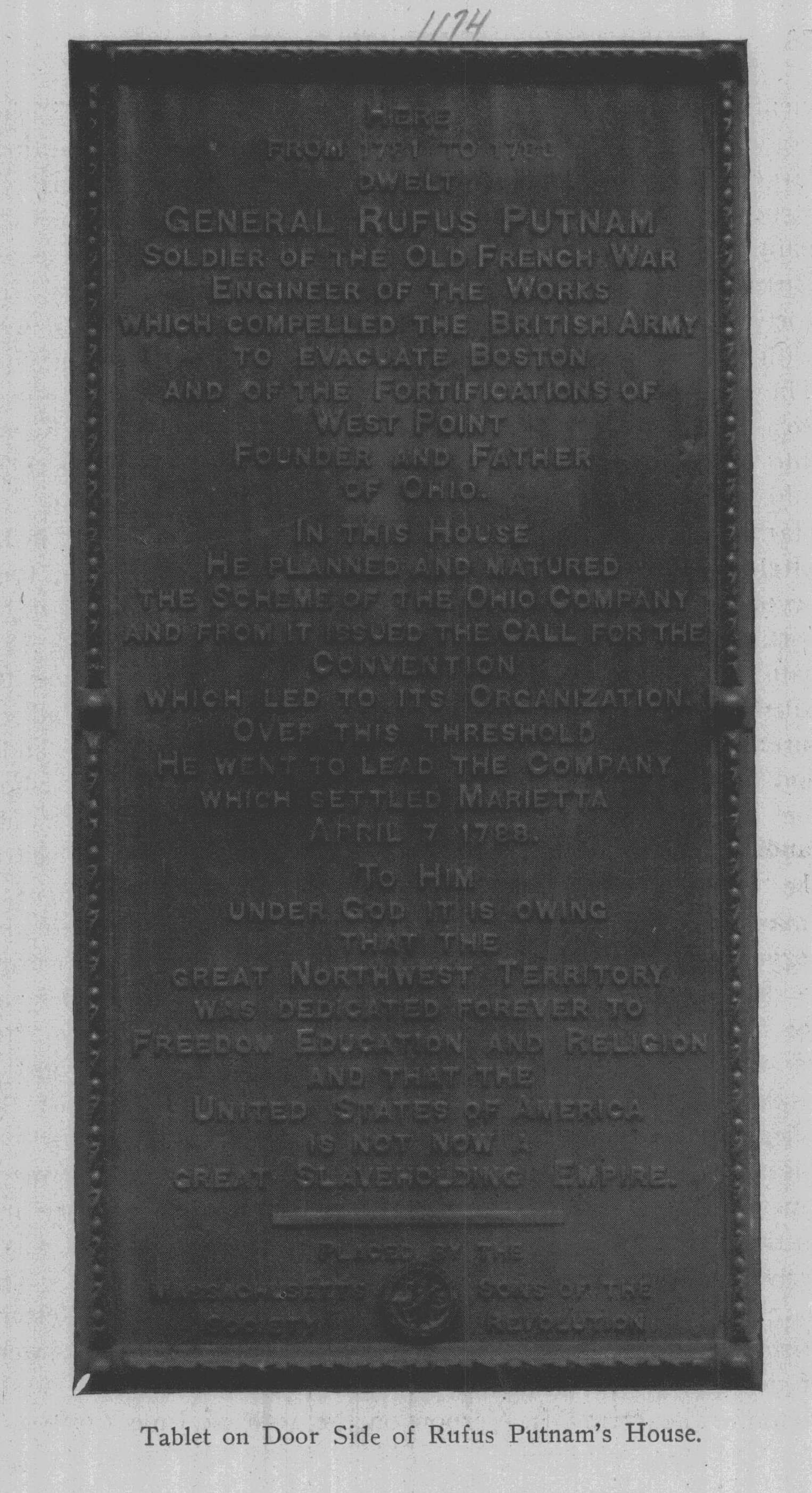
76 Ohio Arch. and Hist. Society Publications.
ciently capacious to carry all the
"forty-eighters" with their
horses, wagons, baggage, tools and
provisions, so an additional
large flat-boat, called the
"Adelphia" and three canoes were con-
structed. In this little fleet the
advance corps of the Ohio Com-
pany "set sail," April 1,
1788, under the command of General
Rufus Putnam, superintendent of the
settlement. There were
forty-eight men in the expedition, no
women or children were
with this advance contingent. The
families were brought later.
The flotilla glided down the
Youghiogheny into the Mononga-
hela and finally passing under the
shadow of Fort Pitt swung
into the "broad bosom of the
Ohio." This journey is a thrice
told tale, not to be here repeated. The
pioneers arrived at Fort
Harmar, just below which they hauled to
on April 7, 1788, in the
afternoon amid fog and rain. The current
had carried them
beyond their intended landing point. The
commandant of the
fort, Major Doughty, sending some
soldiers to their aid, Put-
nam's little band towed the boats up
stream, and crossing the
Muskingum, landed upon the site of
Marietta. The "adven-
turers" were welcomed by a party of
about seventy Wyandot
and Delaware Indians, warriors, women
and children, of whom
the famous Captain Pipe was the
principal character. The
landing of the stores and baggage was
begun at once as well as
the erection of General Putnam's large
tent, known as a
"marquee," a portion of the
plunder taken by General Putnam's
regiment from the British at the
surrender of Burgoyne's army
in the Revolution. Thus was planted the
Marietta settlement,
the first purely colonial one in the
Northwest Territory after
its organization. There were many white
settlers in various
localities, traders' stations,
missionary posts, etc., west of the
Alleghanies previous to the arrival of
the Ohio Company im-
migrants, but the latter was the first
distinct permanent Ameri-
can western settlement. It was the
capital of the Territory and
on the 9th of July (1788) Territorial
Governor Arthur St. Clair
arrived in Marietta and took up there
his official residence. The
founding of this pioneer center is the
starting point of Western
History. It was a most wisely chosen
locality, the settlers were
of the best brawn and brain of New
England. George Wash-
ington wrote from Mt. Vernon on the 19th
of June (1788) to
Rutland-"The Cradle of
Ohio." 77
Richard Henderson on inquiry in regard
to western lands, speak-
ing of the Ohio Company, "No colony
in America was ever set-
tled under such favorable auspices as
that which has just corn
menced at the Muskingum. Information,
property, strength,
will all be its characteristics. I know
many of the settlers, per-
sonally, and there never were men better
calculated to promote
the welfare of such a community. If I
was a young man, just
preparing to begin the world, or if in
advanced life and had a
family to make a provision for, I know
of no country where I
should rather fix my habitation than in
some part of the region
for which the writer of the queries
seems to have a predilection."
Washington knew whereof he spoke for in
his voyage down the
Ohio in the Autumn of 1770 he was at the
mouth of the Mus-
kingum and noted its advantages as a
location for a western
settlement.
*
* * * *
Thus historic Rutland was the
"Cradle of Ohio. In the
old Putnam house, now the cherished and
well-preserved property
of "The Rufus Putnam Memorial
Association," inaugurated by
the late Senator George F. Hoar of
Massachusetts, was born
the purpose and plan of the Ohio
Company, when on that
never-to-be-forgotten night of January
9, 1786, Rufus Putnam
and Benjamin Tupper turned their backs
upon the trials and
hardships of the past and looked with
hope and courage to
peaceful homes for their declining years
on the banks of
La belle Riviere.
It was in September, 1790, that General
Putnam, who in
the meantime had made several trips back
and forth, left his
Rutland residence for his Western home
with his family consist-
ing of wife, five daughters and two
sons, the latter William
Rufus and Edwin. The hired men and
teamsters and some
neighbors who united in the emigration
made the party number
in all twenty-six. Benjamin Franklin
Stone, then a boy little
more than eight years of age was one of
the party and subse-
quently in his remarkable autobiography,
begun at the age of
seventy-eight and completed at
ninety-one, told the story of that
journey of eight hundred miles from
Rutland to Marietta. In
his account Mr. Stone says of the party,
"there were three ox-
|
78 Ohio Arch. and Hist. Society Publications. wagons with two yokes of oxen to each, and General Putnam's two-horse carriage and one saddle horse. My mother had one cow, and Putnam had three or four neat cattle, including a bull of choice breed." On the black canvas sides of the wagon of General Putnam, painted by himself, in large white letters were the words, "To Marietta on the Ohio." The plucky pioneer caravan was eight weeks on the journey, proceeding to Sumrill's |
|
|
|
Ferry on the Youghiogheny where they waited a few days till the boats were finished which General Putnam had engaged the summer previous, when he was returning from Ohio to New England. General Putnam lived at and guided the destinies of the Marietta settlement until his death, May 4, 1824. His grave appropriately marked, is in the revered cemetery of Marietta. The monument bears the sentiment, "The memory of the just is Blessed." |
